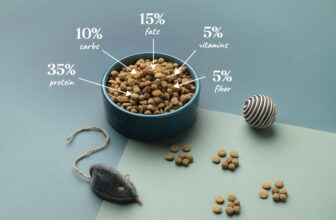
When it comes to choosing the right food for your pet, the information out there can be overwhelming. With so many brands claiming to be the best, numerous diets competing for attention, and an endless stream of advice on what ingredients to avoid, it’s easy to get confused. Myths about pet food have circulated for years, making it difficult for pet owners to distinguish fact from fiction. In this article, we’ll debunk some of the most common myths about pet food and explain what you really need to know to keep your pet healthy.
Myth #1: Grain-Free Diets Are Always Better
The Myth: Grain-free diets have gained popularity in recent years, with many people believing that grains are harmful to pets, especially dogs. Some pet owners assume that their pets are inherently “grain intolerant” and that grain-free food is more natural and healthier.
The Truth: While grain-free diets can be necessary for pets with specific grain allergies (which are relatively rare), most pets tolerate grains perfectly well. Grains such as rice, oats, and barley can provide valuable nutrients like fiber, vitamins, and minerals. In fact, the FDA has been investigating potential links between grain-free diets and an increased risk of heart disease in dogs (specifically dilated cardiomyopathy, or DCM) due to the use of alternative carbohydrate sources, such as legumes and potatoes, which may lack essential nutrients.
What You Should Know: Unless your pet has a confirmed grain allergy, there’s no need to avoid grains. A balanced diet that includes high-quality grains can be healthy and beneficial for most pets.
Myth #2: By-Products Are Unhealthy and Unsafe for Pets
The Myth: “By-products” often get a bad rap in the pet food industry, with many people assuming that these ingredients are nothing more than fillers or low-quality waste products like feathers, hooves, or beaks.
The Truth: The term “by-products” in pet food refers to parts of animals that are not typically consumed by humans, such as organ meats (liver, kidney, lungs) and bones. These by-products are often nutrient-rich and provide important vitamins, minerals, and protein. In fact, many wild animals instinctively consume organs first due to their high nutritional content. When sourced and processed correctly, by-products can be a highly nutritious component of pet food.
What You Should Know: Not all by-products are bad. Look for reputable brands that use high-quality by-products, as they can provide your pet with essential nutrients. Avoid lower-quality brands that use poorly defined “meat by-products” without specifying the source.
Myth #3: Homemade Food Is Always Healthier
The Myth: With the growing interest in natural and holistic pet care, many pet owners believe that homemade pet food is healthier than commercial pet food, thinking they can avoid harmful additives and ensure quality by making their pet’s meals themselves.
The Truth: While homemade food can be a good option, it’s not automatically healthier. Creating a balanced pet diet at home requires precise nutritional knowledge to ensure pets are getting the right amounts of proteins, fats, vitamins, and minerals. A poorly balanced homemade diet can lead to nutritional deficiencies, which may result in long-term health issues.
What You Should Know: If you choose to make homemade pet food, consult a veterinarian or a pet nutritionist to ensure your pet is getting a well-balanced diet. Adding supplements may also be necessary to make up for any missing nutrients. Commercial pet food, especially from reputable brands, is carefully formulated to meet pets’ dietary needs, making it a reliable option for many owners.
Myth #4: Raw Diets Are the Most Natural and Healthiest Option
The Myth: Advocates of raw food diets often claim that since wild animals eat raw meat, it’s the healthiest option for pets. They argue that cooking depletes nutrients and that raw diets are more natural, leading to healthier skin, coat, and digestion.
The Truth: While raw diets can work for some pets, they carry risks that must be carefully considered. Raw meat can harbor bacteria like Salmonella and E. coli, which can be harmful to both pets and humans. Additionally, balancing a raw diet is complex, and without proper supplementation, pets may miss out on vital nutrients like calcium or certain vitamins.
What You Should Know: If you’re considering a raw diet for your pet, work with a veterinarian to ensure it is nutritionally complete and safe. While raw diets have potential benefits, they can also pose risks, particularly in homes with young children, elderly individuals, or people with compromised immune systems due to the bacteria present in raw meat.
Myth #5: Dogs and Cats Need a Constant Variety of Foods
The Myth: Some pet owners believe that their pets, like humans, need a constantly changing diet to stay healthy and avoid becoming bored with their food.
The Truth: Pets don’t require the same variety in their diet as humans do. In fact, frequently switching pet foods can upset their digestive systems, leading to stomach issues like diarrhea or vomiting. Pets are creatures of habit, and many thrive on a consistent, balanced diet.
What You Should Know: It’s fine to occasionally introduce new foods as treats or supplements, but sticking to a consistent, well-balanced diet is typically best for most pets. If you want to change your pet’s food, do so gradually to avoid digestive upset.
Myth #6: High-Protein Diets Are Best for All Pets
The Myth: Protein is often marketed as the most important ingredient in pet food, leading many to believe that high-protein diets are the best for all pets, regardless of age, breed, or activity level.
The Truth: While protein is essential for building and repairing tissues, not all pets benefit from a high-protein diet. Senior pets, for instance, may require lower protein levels to avoid putting strain on their kidneys. Likewise, pets with certain health conditions (such as liver or kidney disease) may need specially formulated diets that limit protein intake.
What You Should Know: Choose a pet food that matches your pet’s specific nutritional needs based on their age, breed, and health status. High-protein diets can be beneficial for active, working animals but may not be ideal for pets with specific health concerns.
Myth #7: Expensive Pet Food Is Always Better
The Myth: There’s a widespread belief that expensive pet food equals higher quality. Many pet owners assume that if a food costs more, it must contain better ingredients or provide superior nutrition.
The Truth: Price doesn’t always reflect the quality of the ingredients or the nutritional value of pet food. Some high-end brands may charge more for marketing or brand prestige rather than superior ingredients. Conversely, some affordable pet foods are made with excellent, high-quality ingredients that meet all your pet’s dietary needs.
What You Should Know: Focus on the nutritional content and quality of ingredients rather than price. Look for foods that meet AAFCO (Association of American Feed Control Officials) standards and choose brands that are transparent about their ingredients and sourcing practices.
Conclusion
When it comes to feeding your pet, understanding the facts about pet food is essential for making informed decisions. Don’t let common myths lead you astray—what works for one pet may not be ideal for another. Always consult with your veterinarian when choosing or changing your pet’s diet to ensure their nutritional needs are being met. Whether you choose commercial pet food, homemade meals, or even a raw diet, the key is balance, quality, and meeting your pet’s individual needs.





